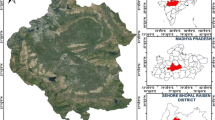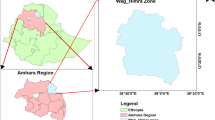Abstract
Water plays a crucial role in fulfilling basic human needs, for socio-economic developments and for ecosystem services. Ethiopia is experiencing pressure on water shortage for agricultural and domestic uses. Arsi Zone frequently faces drought and crop failure due to lack of water sources. Eleven physical characteristics of the study area layers were adopted integrating multi criteria decision analysis, which uses analytical hierarchy processes with a fuzzy logic approach and geographical information system. Soil conservation service model was used to estimate the runoff depth layer of the study area. Weighting was made based on environmental, socio-economical and hydro-geological characteristics of the study area, and available literature. Results show that potential suitability class was not suitable with constraints 5769.8 km2 (27.88%), less suitable 3104.34 km2 (15%), suitable 5695.42 km2 (27.52%), very suitable 4097 km2 (19.8%) and extremely suitable 2027.38 km2 (9.8%). The area coverage of constraints were 4540.37 km2 (21.94%) of the study area. Outcome of this study emphasized the importance of geospatial modeling in assessing rainwater harvesting potential sites, proposed to assist in planning water facility and to address water scarcity problem in the study area. The model developed in this research can be used in other areas to determine the potential of rainwater harvesting and integrate rainwater as an alternative water source to ensure availability for domestic, agricultural and industrial uses. It is recommended that detailed ground validation and socio-economic factors should be analyzed to increase its effectiveness before implementation.











Similar content being viewed by others
References
Ammar A, Riksen M, Ouessar M, Ritsema C (2016) Identification of suitable sites for rainwater harvesting structures in arid and semi-arid regions: a review. Int Soil Water Conserv Res 4(2):108–120
Ayalew L, Yamagishi H (2005) The application of GIS-based logistic regression for landslide susceptibility mapping in the Kakuda-Yahiko Mountains, Central Japan. Geomorphology 65(1):15–31
Baban S, Wan-Yusof K (2003) Modelling optimum sites for locating reservoirs in tropical environments. Water Resour Manag 17(1):1–17
Barron J (2009) Rainwater harvesting: a lifeline for human well-being. UNEP/Earth print, Stockholm
Chang DY (1996) Applications of the extent analysis method on fuzzy AHP. Eur J Oper Res 95(3):649–655
Cheng LS, Li XY, Gao QZ (2005) Actuality and development trend of afforestation by rainwater-gathering in arid and semiarid regions. Arid Land Geogr 28:781–788
Chou WW, Lee SH, Wu CF (2013) Evaluation of the preservation value and location of farm ponds in Yunlin County. Taiwan Int J Environ Res Public Health 11(1):548–572
Conway D, Schipper ELF (2011) Adaptation to climate change in Africa: challenges and opportunities identified from Ethiopia. Glob Environ Change 21(1):227–237
CSA (Central Statistical Agency of Ethiopia) (2008) Summary and statistical report of the 2007 population and housing census. CSA (Central Statistical Agency of Ethiopia), Addis Ababa
De Winnaar G, Jewitt GP, Horan M (2007) A GIS-based approach for identifying potential runoff harvesting sites in the Thukela River basin, South Africa. Phys Chem Earth 32:1058–1067
Destiny Ugo P (2015) A multi-criteria decision making for location selection in the niger delta using fuzzy TOPSIS approach. Int J Manag Business Res 5(3):215–224
Drobne S, Lisec A (2009) Multi-attribute decision analysis in GIS: weighted linear combination and ordered weighted averaging. Informatica 33:459–474
Ebrahimian M, See LF, Ismail MH, Malek IA (2009) Application of natural resources conservation service–curve number method for runoff estimation with GIS in the Kardeh watershed, Iran. Eur J Sci Res 34(4):575–590
Efe SI (2006) Quality of rainwater harvesting for rural communities of Delta State, Nigeria. Environmentalist 26: 175–181. https://doi.org/10.1007/s10669-006-7829-6
Elangovan K, Selva Kumar P (2018) Site selection for rainwater harvesting structures using GIS for the augmentation of groundwater. J Ecol Nat Resour 2(3):000129
Fitsum Y, Hordofa T, Abera Y (2014) Review of water harvesting technologies for food security in Ethiopia: challenges and opportunities for the research system. J Nat Sci Res 4(18):40–49
Getachew A (1999) Water harvesting: a water security strategy for mitigating the impact of drought in Ethiopia. Addis Ababa, Ethiopia
Girma M (2009) Identification of potential rain water harvesting areas in the Central Rift Valley of Ethiopia using a GIS based approach. Master of Science minor thesis. Weganingine University, Netherlands
Glass GV, Hopkins KD (1996) Statistical methods in education and psychology, 3rd edn. Allyn and Bacon, Boston
Gowing JW, Mahoo HF, Mzirai OB, Hatibu N (1999) Review of rainwater harvesting techniques and evidence for their use in semiarid Tanzania. Tanzan J AgricSci 2(2):171–180
Gupta KK, Deelstra J, Sharma KD (1997) Estimation of water harvesting potential for a semiarid area using GIS and remote sensing. remote sensing and geographic information systems for design and operation of water resources systems. In: IAHS publications series of proceedings and reports-intern assoc hydrological sciences, vol, 242: pp 53–62
Hafizi Md Lani N, Yusop Z, Syafiuddin A (2018) A review of rainwater harvesting in malaysia: prospects and challenges. Water 10:506. https://doi.org/10.3390/w10040506
IFAD (2013) (International Fund for Agricultural Development). Water Harvesting Guidelines to Good Practice. Rome
KOICA (2008) Korea International Cooperation Agency, Ex-Post Evaluation on the Project for the Integrated Rural Development in Arsi Zone, Ethiopia
Li Y, Youyi Huang Y, Ye Q, Zhang W, Meng F, Zhang S (2018) Multi-objective optimization integrated with life cycle assessment for rainwater harvesting systems. J Hydrol 558:659–666
Limaye SD (2011) Importance of percolation tanks for water conservation for sustainable development of ground water in hard-rock aquifers. In India, water conservation: an interdisciplinary approach. CRC Press, Boca Raton, pp 20–30
Lyon JG (ed) (2003) GIS for water resource and watershed management. Taylor & Francis, London
Madan K, Chowdary VM, Kulkarnia Y, Mal BC (2014) Rainwater harvesting planning using geospatial techniques and multicriteria decision analysis. Resour Conserv Recycl 83:96–111
Mahmoud SH, Alazba AA (2015) The potential of in situ rainwater harvesting in arid regions: developing a methodology to identify suitable areas using GIS-based decision support system. Arab J Geosci 8:5167–5179
Maina CW, Raude JM (2016) Assessing land suitability for rainwater harvesting using geospatial techniques: a case study of Njoro Catchment, Kenya. Appl Environ Soil Sci. https://doi.org/10.1155/2016/4676435
Malczewski J (2004) GIS-based land-use suitability analysis: a critical overview. Progr Plan 62(1):3–65
Margulis S, Hughes G, Schneider R, Pandey K, Narain U, Kemeny T (2010) Economics of adaptation to climate change: synthesis report. World Bank Climate Change Synthesis Report, Washington, DC
Mbilinyi BP, Tumbo S, Mahoo HF, Mkiramwinyi FO (2007) GIS-based decision support system for identifying potential sites for rainwater harvesting. Phys Chem Earth A/B/C, 32(15):1074–1081
MoA (2015) Ethiopian Ministry of Agriculture. Agricultural Growth Program II (AGP-II). Program design document. MoA, Ethiopia
Mosello B, Calow R, Tucker J, Parker H, Alamirew T, Kebede S, Gudina A (2015) Building adaptive water resources management in Ethiopia. Overseas Development Institute, London
Munyao JN (2010) Use of satellite products to assess water harvesting potential in remote areas of Africa. A case study of Unguja Island, Zanzibar (Doctoral dissertation, MSc Thesis Work), Faculty of Geoinformation Science and Earth Observation in Water Resources and Environmental management, ITC, Enschede
Mutekwa V, Kusangaya S (2006) Contribution of rainwater harvesting technologies to rural livelihoods in Zimbabwe: the case of Ngundu ward in Chivi District. Water SA 32(3):437–444
Ndiritu J, Odiyo JO, Makungo R, Ntuli C, Mwaka B (2011) Yield–reliability analysis for rural domestic water supply from combined rainwater harvesting and run-of-river abstraction. Hydrol Sci J 56(2):238–248
Omar K, Aziz N, Amr S, Palaniandy P (2017) Removal of lindane and Escherichia coli (E. coli) from rainwater using photocatalytic and adsorption treatment processes. Glob Nest J 19:191–198
Padmavathy AS, Ganesha Raj K, Yogarajan N, Thangavel P, Chandrasekhar MG (1993) Check dam site selection using GIS approach. Adv Space Res 13(11):123–127
Prinz D (1996) Water harvesting-past and future. In: Pereira LS, Feddes RA, Gilley JR, Lesaffre B (eds) Sustainability of irrigated agriculture, 1st edn. Springer, Dordrecht, pp 137–168
Prinz D, Singh A (2000) Technological potential for improvements of water harvesting. Gutachten für die World Commission on Dams, technical papers, No.126. Cape Town, South Africa
Prinz D, Oweis T, Oberle A (1998) Rainwater harvesting for dry land agriculture-developing a methodology based on remote sensing and GIS. In: Proceedings of XIII international congress agricultural engineering (pp. 12), ANAFD, Rabat, Morocco
Ramakrishnan D, Bandyopadhyay A, Kusuma KN (2009) SCS-CN and GIS-based approach for identifying potential water harvesting sites in the Kali Watershed, Mahi River Basin, India. J Earth Syst Sci 118(4):355–368
Rockstrom J (2000) Water resources management in smallholder farms in Eastern and Southern Africa: an overview. Phys Chem Earth 25(3):275–283
Rockström J, Falkenmark M, Karlberg L, Holger Hoff H, Rost S, Dieter Gertenet D (2009) Future water availability for global food production: the potential of green water for increasing resilience to global change. Water Resour Res. https://doi.org/10.1029/2007WR006767
Rosegrant MW, Cai X, Cline SA (2002) World water and food to 2025: dealing with scarcity. International Food Policy Research Institute, Washington
Satty T (1980) The Analytical Hierarchy Process. McGraw Hill, New York
Shaheed R, Wan Mohtar WHM, El-Shafie A (2017) Ensuring water security by utilizing roof-harvested rainwater and lake water treated with a low-cost integrated adsorption-filtration system. Water Sc Eng 8(3):195–204
Shamsi U (2005) GIS applications for water, wastewater, and stormwater systems. CRC Press, Boca Raton
Singh JP, Singh D, Litoria PK (2009) Selection of suitable sites for water harvesting structures in Soankhad watershed, Punjab using remote sensing and geographical information system (RS&GIS) approach—a case study. J Indian Soc Remote Sens 37(1):21–35
Sutherland DC, Fenn CR (2000) Assessment of water supply options. A report prepared for the world commission on dams. Cape Town, South Africa
Tabor JA, Hutchinson C (1994) Using indigenous knowledge, remote sensing and GIS for sustainable development. Indigenous Knowl Dev Monitor 2(1): 2–6
Tadesse K (2002) Trends in agricultural production, technology dissemination and price movements of outputs and inputs. Ethiopian Development Research Institute, Addis Ababa
Tamaddun K, Kalra A, Ahmad SJ (2018) Potential of rooftop rainwater harvesting to meet outdoor water demand in arid regions. Arid Land 10:68. https://doi.org/10.1007/s40333-017-0110-7
Tarun K, Jhariya DC (2017) Identification of rainwater harvesting sites using SCS-CN methodology, remote sensing and geographical information system techniques. Geocarto Int 32(12):1367–1388
Tiwari K, Goyal R, Sarkar A (2018) GIS-based methodology for identification of suitable locations for rainwater harvesting structures. Water Resour Manag 32:1811. https://doi.org/10.1007/s11269-018-1905-9
UN (2014) The United Nations world water development report 2014: water and energy. United Nations, Paris
Vahidnia MH, Alesheikh A, Alimohammadi A, Bassiri A (2008) Fuzzy analytical hierarchy process in GIS application. Int Arch Photogramm Remote Sens Spatial Inform Sci 37(B2):593–596
Van Dijk J, Reij C (1994) Indigenous water harvesting techniques in sub-Saharan Africa: examples from Sudan and the West African Sahel. In: FAO, water harvesting for improved agricultural production. Expert Consultation, Cairo, Egypt 21–25 Nov. FAO, Rome, p. 101–112
Zadeh LA (1965) Fuzzy sets. Information control 8(3):338–353
Zhang L, Shi C, Zhang H (2010) Effects of check-dams on sediment storage-release in Chabagou Watershed. Trans Chin Soc Agric Eng 26:64–69
Acknowledgements
We are thankful to the School of Earth Sciences, Addis Ababa University for support, facilities and funds. We are also grateful to the National Metrological Agency and Oromia Agricultural Research Institute for providing necessary data to support this study. Mr. Getachew Haile indebted to Oromia Agricultural Research Institute for sponsoring for higher studies in Remote Sensing and Geoinformatics.
Author information
Authors and Affiliations
Corresponding author
Rights and permissions
About this article
Cite this article
Haile, G., Suryabhagavan, K.V. GIS-based approach for identification of potential rainwater harvesting sites in Arsi Zone, Central Ethiopia. Model. Earth Syst. Environ. 5, 353–367 (2019). https://doi.org/10.1007/s40808-018-0537-7
Received:
Accepted:
Published:
Issue Date:
DOI: https://doi.org/10.1007/s40808-018-0537-7




